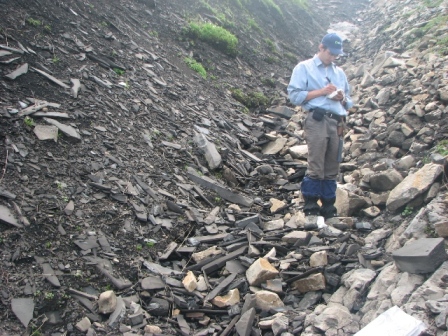-
Biography:
- My time as an undergraduate was spent at the University of Birmingham in the UK, where I studied for a master’s degree in Geology. During my time at Birmingham I was awarded the Lapworth Scholarship by the Department of Earth Science and also took part in an international exchange program that saw me spend the third year of my degree at the University of British Columbia. On returning to the UK I completed my master’s thesis on the conodont biostratigraphy of the Ordovician Horn Valley Siltstone Formation in central Australia. I decided to return to Canada to begin my PhD studies at UBC in 2009. Prior to this, I spent the summer working as a field assistant for the B.C. Ministry of Energy and Mines. My work at UBC involves an integrated biostratigraphic and sedimentological study of the Lower and Middle Triassic rocks of northeastern British Columbia, particularly the subsurface Montney and Doig formations and their surface equivalents, the Toad and Liard formations. During my time at UBC I have been awarded a Four Year Fellowship by the Faculty of Graduate Studies as well as the Shell GeoCanada Prize. I also served on the department’s graduate committee as the student representative. On completion of my PhD I hope to further contribute to the development of the hydrocarbon industry in Canada.
Martyn Golding, PhD student, University of British Columbia
Project: Biostratigraphy and Correlation of the Triassic Montney and Doig Formations, Subsurface British Columbia
The Montney and Doig formations occur in the subsurface of northeastern British Columbia, and contain large reserves of natural gas, making up 37% of the total reserves for the province. They were deposited in the Western Canada Sedimentary Basin during the Lower and Middle Triassic. The basal unit of the Doig Formation, the Doig Phosphate Zone, is an important stratigraphic marker as well as a source rock for a number of reservoirs in both the Montney and Doig formations. The age of this unit is poorly constrained, with estimates ranging from the Smithian (upper Lower Triassic) to the Ladinian (upper Middle Triassic). It is not known whether this unit is diachronous. In order to constrain the age of the Doig Phosphate Zone and to elaborate on its relationship with the underlying Montney Formation, samples will be collected from drill core in the Trutch (NTS 94G), Fort Nelson (NTS 94J) and Maxhamish (NTS 94O) map areas. These samples will then be processed for conodonts, to allow the biostratigraphic framework of the two formations to be determined. This will build on previous work funded by Geoscience B.C. which investigated the conodont biostratigraphy of subsurface sections in the Halfway River (NTS 94B), Charlie Lake (NTS 94A) and Dawson Creek (NTS 93P) map areas, as well as surface outcrop in the Halfway River and Tuchodi Lakes (NTS 94K) map areas. Understanding the biostratigraphic framework of the Montney and Doig formations will allow correlation of the hydrocarbon producing parts of these units, and will also provide insight into the evolution of the Western Canada Sedimentary Basin. These outcomes will in turn facilitate hydrocarbon exploration in B.C.
Deliverables
-
Thesis
-
- Biostratigraphy and Sedimentology of Triassic Hydrocarbon-Bearing Rocks in Northeastern British Columbia: University of British Columbia, 2014 – Available digitally through University of British Columbia (PDF, 11.84 MB)
-
